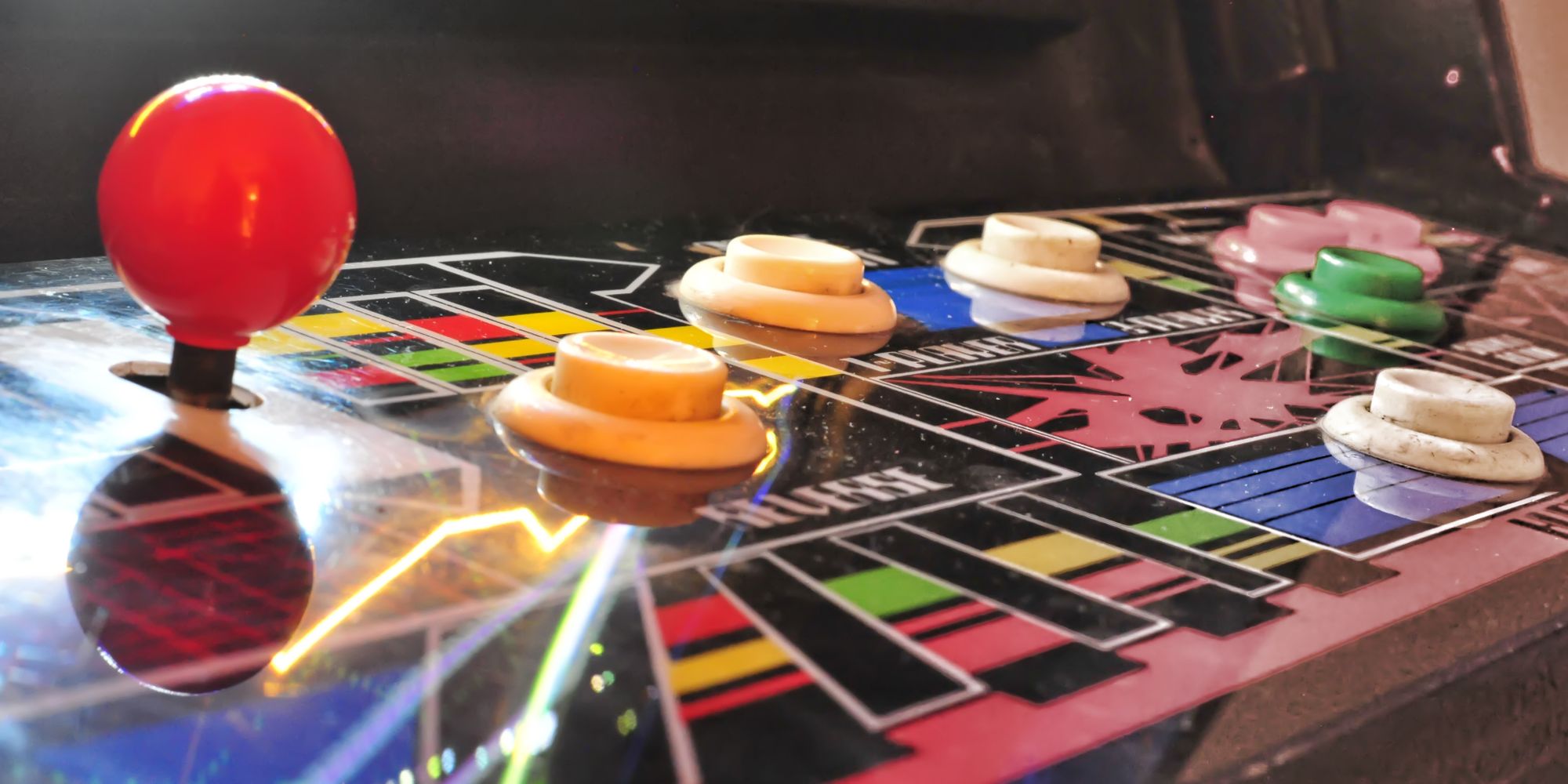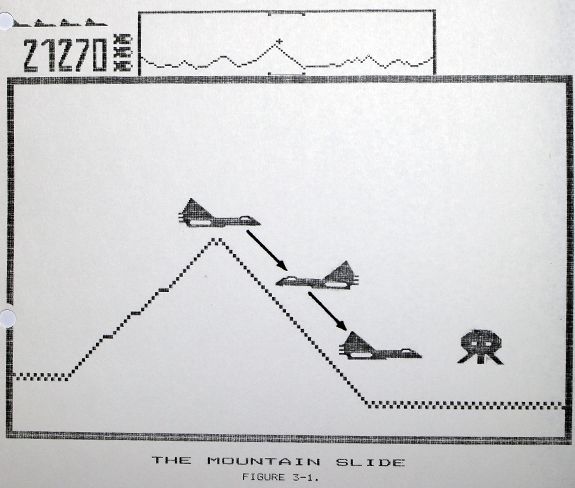Defender, Chapter 3: Landers

Landers are the least dangerous opponents in the game of Defender, and most players don’t have any trouble with them. There are, however, a few things to keep in mind while shooting landers that will help you finish waves quickly and safely.
All landers begin moving to the left or right as soon as they appear. They also drop down to just above the planet’s terrain and stay at that altitude except when they’re picking up humanoids. By traveling at this same altitude, you can assure that every lander will pass through your line of fire.
The first thing you’ll notice wrong with traveling at the same altitude as the landers is that your ship can’t track changes in the terrain as fast as landers do, and sometimes the lay of the land will pull a lander above or below your line of fire. When this happens, you’ll be tempted to think that the lander dodged your shot, but don’t give him so much credit; if you had anticipated his motion, you could have made it look like he intentionally jumped into your line of fire.
Missed Landers
If you miss a lander that is traveling the opposite direction that you are, it’s often best to just let him go and remember to get him the next time around. It’s risky to pull in quickly behind a lander after passing above or below him; landers are terrible shots, but it doesn’t take much accuracy to hit your ship when it’s that close. You should try to shoot a missed lander only if he’s traveling the same direction you are, because it will take a long time to overtake him again.
The safest way to handle this situation is either to come to a complete stop before dropping down to fire or wait until the lander is off the screen and turn around and go back to him. Both these maneuvers waste several seconds, so good players try to get a feel for when the lander will fire and then just drop in right after his first shot to finish him off. The timing on this maneuver is very important, and will require some practice before it is effective.
Landers' shooting
Landers, as we noted above, are bad shots except at very close range. A lander’s bad marksmanship is intentional, to give you a break, and here’s how it works: the lander calculates what angle he should fire at to hit your ship, and then randomly shoots within an arc centered around that angle (mutants and baiters also aim their shots by this procedure). This means that the lander will always shoot in the general direction of your ship, but rarely shoots directly at it. When your ship is very close to the lander, it covers his entire firing arc, and any shot he takes then will hit you.
Half the shots that landers, mutants, and baiters take have the velocity of your ship added to them. These shots are called chasers, and all other shots are lob shots. Chasers follow your ship for several seconds, even after the lander that fired them is completely off the screen. These shots are best avoided by moving up or down, rather than trying to fly away from them, because chasers don’t take your vertical motion into consideration.
Spotting (and stopping) the pick-up
Watch the landers as they appear for signs that one of them is about to pick up a humanoid. If a lander begins shooting rapidly and moving straight down as soon as he appears, he is letting you know – unintentionally, of course – that he is going to pick up the man directly below him.
Landers should be watched closely when the pass over a humanoid. If a lander suddenly stops moving, he is going to start firing at you and move down to pick up the man. This situation is dangerous for two reasons – there is the danger of being hit by a bullet, and the mere presence of the lander’s bullet on the screen will slow down the response of your fire button. Be patient, avoid the bullets, and keep firing.
Sliding down the mountain
Another common problem with landers occurs when flying to the right near the big mountain. Sometimes you’ll find that a humanoid has naively climbed to the top of the mountain, forcing you to fly at a very high altitude to keep from shooting him. Or, you might be carrying a humanoid and avoid flying through the mountain because you don’t want to set him down yet. In either case, your ship’s forward momentum will carry you over the top of any landers in the low area to the right of the mountain. There is a simple maneuver that will avoid this problem. Just before passing over the topic of the mountain, reverse and hold the thrust on while pulling down on the altitude lever. This power brake will slow the ship down enough that you can come down the right side of the mountain, reverse again at the bottom, and come out firing. In a well-executed mountain slide, the front of your ship should drag along the right side of the mountain as you come down.

Shooting from the inside
Another good lander move to work on is pulling up between two landers and shooting them both by firing, reversing, and firing again very quickly. This maneuver is simple and obvious; the only reason that I mention it is that it’s important to think of it as a single maneuver. That way, when two landers suddenly appear above your ship, you will automatically react to the situation.
If both landers are traveling the same direction, try to shoot the one that is approaching you first so he doesn’t run into you while you’re shooting the other one. If they’re traveling in opposite directions (both moving towards you), you can either pull in between them and try to shoot them both quickly, or wait for them to pass and then shoot them while they’re moving away from each other.
Which way to go
It takes a long time to overtake a lander traveling away from you. This fact plays an important part in finishing off higher waves, where saving a few seconds can make the difference between dealing with one baiter or many. When there are only landers left in a wave, pay close attention to which direction they are moving. If nearly all of them are moving the same direction that you are, turn around so that they’re coming towards you. Although this may seem like a small point, it is one of the biggest flaws in the game of otherwise good players. By going the wrong way when there are only landers or bombers left, these players encounter more baiters, die more often near the end of a wave, and are never able to put together a good turn of several waves in a row.
The other problem with going in the same direction as the remaining landers is that is that it puts your ship on the screen with each lander for a longer time than if you turn and meet them. Consequently, it is more likely that a lander will be able to shoot you, since he can get off more shots.
Landers behind you
Earlier, we looked at how to handle a lander that you have missed and passed by. You can also have landers show up behind your ship when they beam in, or when you turn around for something. In these situations, it is usually better to keep going forward than to turn and go back to the lander. A good habit to get into, though, is to turn and fire a burst of four shots at any lander that is behind you, and keep going forward whether it hits him or not. The lander isn’t worth going back for, but you don’t lose anything by trying to hit him. Just make sure your pride doesn’t make you turn around and go back for him if you miss. Many players turn and chase landers they have missed, as if the act of firing at a lander commits them to finishing him off.
Constant firing
My final advice about shooting landers concerns use of the fire button. Many players get in the habit of constantly firing, even when there is nothing on the screen. I have even heard fairly good players declare that this is a good habit, since it keeps you from running into landers. This is not always true, especially when the machine is very busy and the 4-shot limit comes into play. When the game has slowed down to the point where your first shot has not reached the front edge of the screen before you try to fire for the fifth time, you must try to never have four live shots on the screen. Otherwise, you’ll run into an opponent by firing at him after reaching the shot limit.
By making every shot count (that is, every shot is aimed at and hits a chosen opponent), your flying speed can remain constant when the machine is busy. If you fire constantly, you must slow down when the machine gets busy, so that you don’t run into opponents before the fire button can react. Constant firing may improve your score slightly when you’re first starting out, but it should be avoided by players who intend to completely master the game.
- About this book
- Introduction
- Chapter 1: Getting Started
- Chapter 2: The Controls
- Chapter 3: Landers
- Chapter 4: Mutants
- Chapter 5: Swarmers
- Chapter 6: Bombers
- Chapter 7: Baiters
- Chapter 8: Catching Humanoids
- Chapter 9: Free Space
- Chapter 10: Strategy
- Chapter 11: Miscellaneous
- Chapter 12: Stargate
- Chapter 13: Attitude
- Acknowledgments